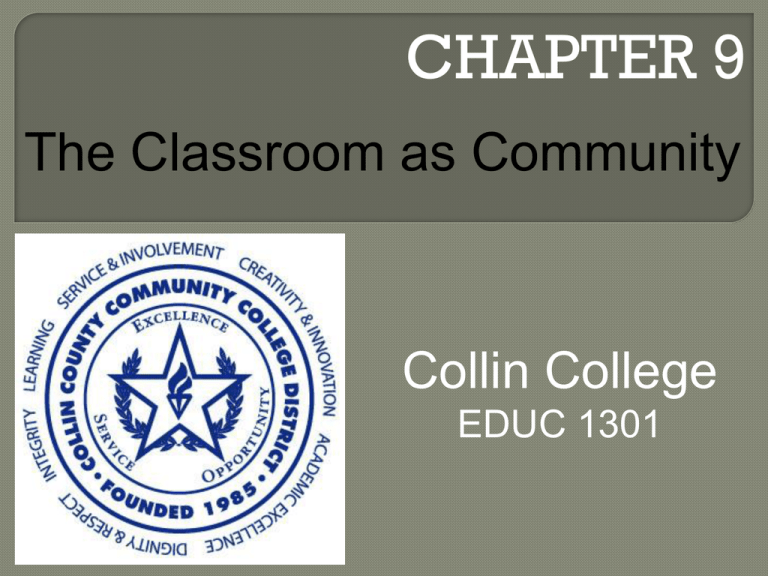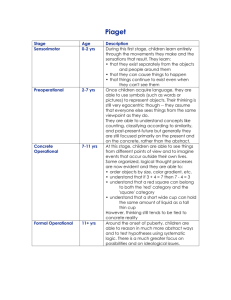
CHAPTER 9
The Classroom as Community
Collin College
EDUC 1301
Cooperation
and shared purpose are
best established through the quality of
the learning experience.
• Show genuine interest in your students’ learning
• Engage your students in meaningful
experiences
• Use your authority appropriately, to set
boundaries-with the students- that guide the way
the classroom operates
Classroom
management: Teacher
creates good learning environment
through rules and control of conditions
Classroom community:
• Teachers work with students to create shared
conditions for learning.
• Rules are established by the group
• There is a shared purpose and common values
How
they learn is as important as what
they learn
To succeed academically, students must
develop social skills:
• Cooperation
• Assertion
• Responsibility
• Empathy
• Self-control
Responsible, calm
adult in charge
Sensible, consistent rules & routines
Active, lively, and natural
Noise level matches activity
Inappropriate behaviors are redirected
Students learn and grow
Emotional
safety
• Individuals treat each other with respect
• Teacher is confident, warm, happy- a centered
presence in the classroom
• Rules are enforced fairly and consistently
• Create a sense of belonging
Share personal stories, connect
Give students responsibility (class jobs)
Distraction
(1 – 2 1/2 Yrs)
Anticipation and Avoidance (1 – 2 ½)
Removal from Activity (1 – 5 Yrs)
Positive Reinforcement (1 – 18 Yrs)
Time Out (2 – 12 Yrs)
Natural/Logical Consequences (2-18)
Negotiation (5 – 18 Yrs)
Contract Agreement (10 – 18 Yrs)
Establish
rules and routines
• Define them clearly
• Have students help
Ensure
students’ compliance
• Establish positive relationships
• Be willing to administer consequences
Involve
families
• Communicate
• Make sure they understand rules
Copyright by Houghton Mifflin Company. All rights
reserved.
68
Be clear and specific
State the rule positively
State the rule so that compliance is clearly observable
Only make rules you are willing to enforce
Expect resistance
If you cannot directly observe compliance, establish
consequences for discovered noncompliance
Remember, “less is better” or quality is better than
quantity
Anticipate and make rules in advance
Change rules as need
Involve children in making rules
Community
service is integrated with
learning
Benefits:
• Allows students to use their strengths to make a
meaningful contribution;
• Fosters well-being and a sense of purpose;
• Strengthens community ties to school;
• Culturally relevant team work enhances
personal self-esteem
Unwelcome
sexual advances, requests
for sexual favors, creation of a hostile
environment
• 80% of students are sexually harassed during
their school years
• 40% report teachers or staff sexually harass
students in their schools
• Schools can be held liable for student behavior
Understand
school policy
• Make sure students understand and know how to
report abuse
Establish
a sense of community in class:
• If students feel responsible for one another,
harassment less likely
• Foster communication
• Develop specific behavioral guidelines with
your students!
Repeated
cruelty inflicted by a powerful
person or group of people on a weaker
person
• Types: Intimidation, spreading rumors, name-calling,
assault, blackmail, theft, isolation, cyber-bullying on
Facebook and Twitter.
• Most common targets: Gays
• Victimization linked to depression, eating disorders,
suicidal tendencies
• Most students won’t report the incidents; the teacher
must create a climate where reporting is
commonplace!
Percentage of students aged 12-18 who reported
school bullying in past 6 months
Source: Data from Dinkes, R., Cataldi, E.F., Kena, G., Baum, K., & Snyder, T.D. (2006). Indicators of school crime
and safety: 2006. NCES 2007-003/NCJ 214262. Washington, DC: U.S. Government Printing Office.
Harassment
through electronic means (email, website postings, text messaging,
blogs, mobile phones, Facebook and
Twitter)
• It is a Federal crime to anonymously abuse any
person via telecommunications system
Educator’s
Guide to Cyberbullying and
Cyberthreats can be found at “Beware of the
Cyber Bully,” iSAFE, Inc.
http://www.isafe.org/imgs/pdf/education/
CyberBullying.pdf
Don’t
open, read, or respond to messages
from known cyber-bullies
Don’t erase messages
Tell your school (teacher, principal,
guidance counselor) if it is school-related
If threatened, call the police
Block those who are using chat or instant
messaging to bully. Think carefully
before giving out private information
online such as passwords, PINs,
addresses, or phone numbers.
To
foster a sense of a learning
community:
• Honor diversity
• Be honest and show interest in their lives
• Make lessons and methods meaningful
Work
with students to create/enforce
rules:
• Improves learning
• Reduces chance of harassment, bullying
In
pairs, decide upon 4-5 simple
classroom rules to help ensure an
orderly learning environment
Share with the class as appropriate
when asked
Copyright by Houghton Mifflin Company. All rights
reserved.
619



